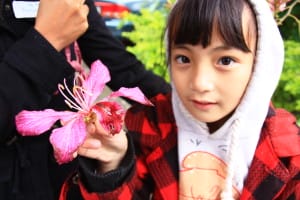How we came to ChingChuan! Our first times volunteering out there and falling in love with the community.
Foreign nationals offer children’s art workshop in remote Atayal village
By Lin Yang,CNA
September 26, 2011
China Post
CNA–A convoy of foreign nationals descended on a remote mountain village one and a half hours’ drive east of Hsinchu City Saturday, bringing with them paint, brushes and canvas for a workshop for the aboriginal children that live there.
The volunteers are part of the Aboriginal Children’s Project, a hodgepodge of artists, photographers, English teachers and philanthropists who organized on Facebook to provide artistic enrichment to indigenous children.
They currently work in Chingchuan, a small village of the Atayal Tribe. The village has a Catholic church led by an American priest who has been there for 35 years. But until the Aboriginal Children’s Project rolled into town, many of the village children had never seen another foreign national.
Now the children had teachers from eight different countries, offering workshops in abstract painting, still-life drawing and group canvas painting in one afternoon.
Although restive at times, the children were incredibly eager to sketch the world they live in.
Wang Kuan-chun, 14, peppered two sheets of paper with a smorgasbord of colors in his interpretation of abstract art. He later explained that he had painted a car and a heart.
“I drew a heart because love is needed in the world. And a car, well, because I need it,” he said.
For Chingchuan’s children, the lack of transportation to the cities of Taiwan poses a significant barrier to opportunities.
Many cannot get to the nearest high school in Zhudong, which is 45 minutes away. The occasional bus does not arrive in the village until well after school starts, which effectively ends the children’s chances at higher education. Those who want to attend high school must move to Zhudong, where housing prices and living expenses are high.
According to Yeh Ching-chuan, 45, a member of the tribe who works at the church, many children grow up to work in the lowest paying jobs in construction, farming and forestry. The isolation of their community breeds rampant alcoholism and drug use.
She said parents are often absent, either working in cities or succumbing to alcohol and drug abuse. This leaves children with very little support or examples of success.
“I’d say out of every 20 children, maybe one will go to college,” Yeh said.
Nationally, the college enrollment rate in 2010 was 67 percent, according to Ministry of Education statistics.
Some of the children in the still-life workshop were unruly in the structured learning environment.
Constantly interrupting the workshop teacher to gain attention, one child boasted that he was an amazing artist already, and the stuff being taught was so easy for him. Another stopped the class because he did not have a pencil.
At one point, the teacher’s voice started rising to a level much higher than is considered polite, even in Taiwan.
Because so many of the children in the community have bleak futures, enrichment activities like this art workshop could be the last line of defense against a life of poverty.
“If they didn’t have activities like this, they would be completely on their own,” Yeh said.
The project is the brainchild of Malinda Schultz, 30, an American artist who currently lives in Hsinchu. She got the idea from watching the documentary “Born Into Brothels,” and ran a pilot project last year in Hualien, where she gave disposable cameras to disadvantaged children and asked them to document their lives.
Schultz said it was her experience as an English teacher that motivated her to start the group.
“Many Taiwanese don’t want their kids to do art. But kids are a great source of creativity, because their minds are free. Art is such great development for their brain,” she said.
With the help of Barry Martinson, the American priest in the community, Schultz is running both the art workshop as well as a second round of her photography project in the village. Martinson and Schultz plan to exhibit the children’s photography and art in Taipei this November, and will auction the works to raise money for a new community center in Chingchuan.
The hope is that a community center will encourage more volunteers to come up the mountain and teach enrichment classes for children and adults.
Two hours into the workshop, the kids were painting three large canvases that will be hung on a wall during the auction in November. Schultz said this kind of enthusiasm is one of the reasons she finds the work so rewarding.
“I would teach English to kids in the city for three years, and they still refused to speak a word because they were forced to take the classes,” she said. “These kids want to paint. Look at them. They’re still here.”
https://www.chinapost.com.tw/taiwan/local/hsinchu/2011/09/26/317781/Foreign-nationals.htm
